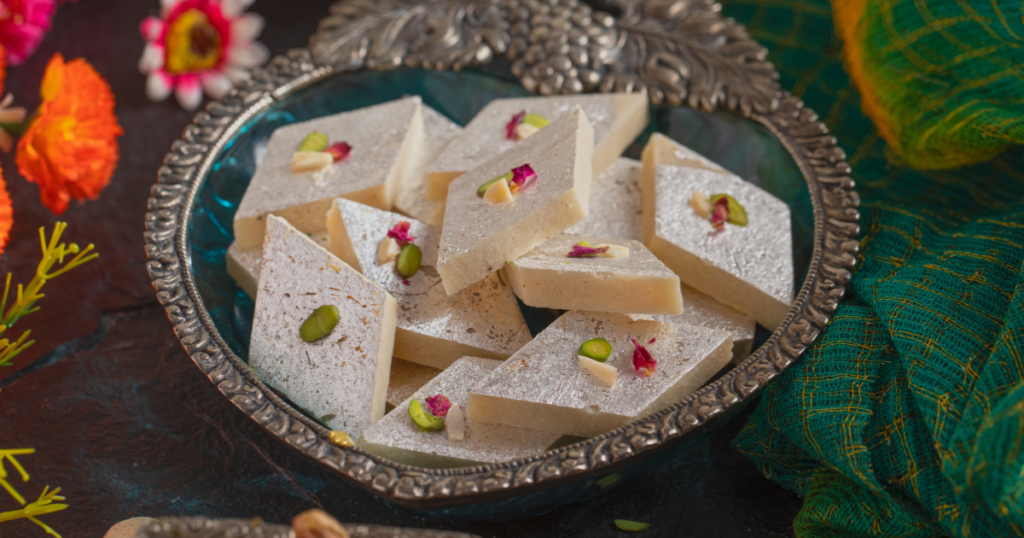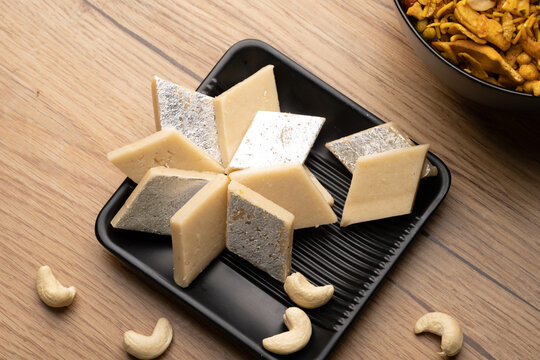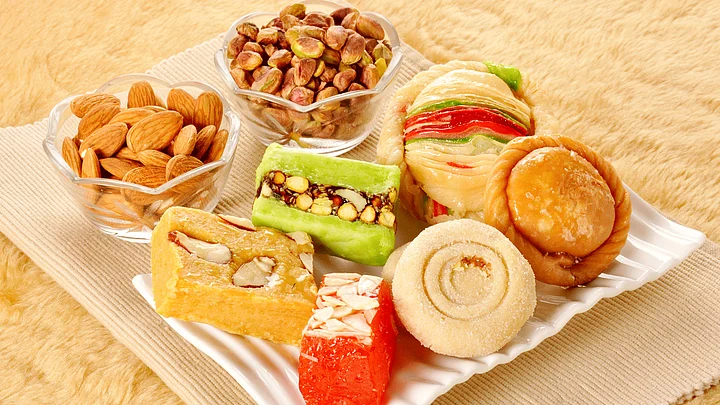Introduction: A Symphony of Flavors and Light
When autumn winds begin to whisper through the neem and marigold leaves, India senses the shift — the festive season is near. For many households, this is a time when the kitchen becomes a stage, and the aromas of spices, ghee, cardamom, saffron, and nuts are the overture. Festive recipes in India do more than satisfy a sweet tooth: they are stories, heirlooms, and emotional bridges between past and present.
Karwa Chauth 2025: Fasting, Devotion & Flavor
Among the many festivals in India, Karwa Chauth holds a unique place. It is a day of devotion, love, and aesthetic ritual: married women fast from sunrise to moonrise for the well-being of their husbands, observing a sequence of rituals, prayers, and silence. But behind the glimmering sieve, mehendi-stained hands, and ritual puja lies the softer side — the food.
The Heart of Sargi: Dawn Blessings in Food
Sargi is the pre-dawn meal given to the wife by her mother-in-law — a gesture of love, sustenance, and care for the long fast ahead. In 2025, kitchens are reinventing Sargi plates with a blend of tradition and light innovation.
Picture a silver plate adorned with:
- Soft, saffron-tinted pheni soaked in warm milk with crushed almonds.
- A cluster of dates, figs, walnuts, and pistachios — nature’s energy bombs.
- Coconut burfi cubes or dry fruit laddoos — rich but manageable.
- Fresh slices of pomegranate or guava to hydrate and refresh.
- A small cup of rose-infused chia water — a trending 2025 Sargi glow drink said to sustain energy and promote radiant skin.
The ritual is as much visual as nutritional. In many homes, the Sargi platter is garnished with marigolds or rose petals, a little gold tinsel, and a handwritten blessing. In some villages, mothers still recite an old verse or short prayer while placing each item — an invisible thread connecting generations.

Breaking the Fast: Moonrise Delicacies
When the first sliver of moon peeks through tree branches or buildings, the fast is broken. But the first morsel must be gentle: traditionally, sipping water or milk, sometimes sweetened, and then consuming a few soaked almonds or dates. Only after prayers is the full meal served.
Here are a few Karwa Chauth recipes that balance comfort with celebration:
- Makhana Kheer with Rose Petals: Lotus seeds slow-cooked in milk with cardamom and saffron, garnished with rose petals and slivered pistachios.
- Soft Beetroot Halwa: Grated beetroot cooked in light ghee with a hint of jaggery; bright, aromatic, and digestible after fasting.
- Gulkand & Rabri Phirni: A creamy rice pudding layered with sweet rose petal preserve (gulkand) — indulgent but soothing.
- Mini Moong Dal Laddoos: Light lentil-based balls, packed with cardamom, dry fruits, and a whisper of ghee — perfect bite-sized comfort.
- Millet Paratha Rolls: Thin finger millet (ragi) or jowar parathas stuffed with spiced paneer or mixed vegetable filling — wholesome and gently spiced.
These dishes heal the body after a fast, and their flavors echo devotion, sweetness, and gratitude.

Dhanteras 2025: Prosperity, Ritual, and Golden Kitchens
The very next day comes Dhanteras — the auspicious start to Diwali festivities. Dhanteras is about wealth, health, and good beginnings. In many homes, people purchase silver, gold, or utensils, and light diyas around the Lakshmi shrine. The food prepared is often golden in hue, rich enough for offering but balanced for later indulgence.
Traditional Sweets for Auspicious Offerings
Food on Dhanteras is symbolic: the color gold (dal, besan, saffron), warmth (ghee, jaggery), and richness (dry fruits). Some beloved preparations include:
- Besan Laddoo: Gram flour roasted in pure ghee, sweetened with jaggery or sugar, shaped into golden spheres — the timeless festive favorite.
- Moong Dal Halwa: Yellow moong dal cooked slowly with milk, ghee, cardamom, and dry fruits. Often prepared in big kadhai and shared with neighbors.
- Kesar Peda: Soft, saffron-infused peda, perfect for offering to goddess Lakshmi.
- Til-Gur Ladoo: Sesame seeds bound with jaggery — sweet, crunchy, and seasonal.
- Dry Fruit Kachori: Crisp pastry filled with finely chopped dry fruits, lightly sweetened — ideal for gifting.
Many homes prepare two kinds: one for prasadam / offerings and another slightly different version for family dessert consumption.
Snack Innovations for Dhanteras
As 2025 leans into mindful wellness, many kitchens are creating lighter versions of traditional festival snacks:
- Baked Mathri with Carom Seeds: Crisp, aromatic, and lighter on oil.
- Roasted Poha Mixture with Nuts and Raisins: Sweet-spicy blend, easily packable.
- Nut & Seed Bars: Dates, almonds, flax, sesame, and a touch of jaggery pressed into festive bars.
- Jaggery-Coated Roasted Chana: Crunchy, sweet, and deeply traditional.
These are perfect day-of snacks to nibble while you prepare grander Diwali recipes or entertain guests.
Diwali 2025: The Grand Feast of Light and Flavor
Finally arrives Diwali, the Festival of Lights, on November 1, 2025. Homes glow with diyas, rangolis, and warmth — but the true glow comes from the kitchen. It’s a day for indulgence, variety, and culinary showmanship. Every corner of India brings its regional specialties, family secrets, and new experiments to the table.
Sweets That Steal the Show
Here are some festive sweets that dominate Diwali tables — both classic and contemporary:
- Kaju Katli (Modern & Fusion Variants): The classic, with a twist in 2025 — rose-scented, layered chocolate, or with edible gold leaf for that showstopper box.
- Motichoor Ladoo: Tiny boondis bound in sticky syrup, bright-colored and deeply festive — an evergreen favorite.
- Gulab Jamun & Gulab Jamun Cheesecake: The syrup-soaked classic mashed into cheesecake form — a crowd-pleasing hybrid.
- Coconut & Date Barfi: Pure coconut cooked with dates or jaggery — a chewy, healthy twist.
- Rasmalai Towers: Soft paneer discs soaked in saffron milk, stacked in decorative layers for dramatic presentation.
- Mysore Pak: South India’s gift to Diwali — rich, buttery, with a melt-in-mouth texture.
- Pista Rolls & Kesar Burfi: Nut-filled sweets that blend richness and subtle flavor.
Savory & Snack Staples
A Diwali party isn’t complete without namkeen. Some crowd favorites:
- Masala Mathri & Namak Pare: Flaky, savory, and perfect with evening chai.
- Chakli / Murukku: Spiral snacks from the South — crisp, spiced, and wonderfully addictive.
- Aloo Bhujia & Sev: Spiced potato-based crunchy strings — perfect as a topping or snack.
- Mini Samosas & Paneer Pakoras: Party bites with spicy potato or paneer filling.
- Cornflakes Mixture / Chivda: Light, sweet-spicy, and easy to store.
- Baked Kachori & Baked Mathri: The 2025 trend — lowering oil, retaining flavor.
Families often create snack towers — tall jars or pyramid displays of multiple crisp types, so guests can nibble and mix as they like. It’s as much an aesthetic gesture as it is culinary.
Presentation & Dining Rituals
- Sweets are placed on silver or brass thalis, often lined with banana leaves or colorful paper.
- Use rose petals, marigold petals, or edible silver flakes as garnish.
- Offer small portions on decorative leaf-plates to guests — a gesture of abundance and sharing.
- Use glass jars and jars with labels to display sweets and snack mixtures — they stay fresh and invite visual appeal.

Bollywood’s Festive Kitchens: How Celebs Celebrate in 2025
If there’s one thing that unites Bollywood and festive food, it’s glamor — and a dash of innovation. In 2025, several stars made headlines for their kitchen choices and festive menus. These stories inspire home cooks and spark social media trends.
- Deepika Padukone’s Home Diwali: She candidly shared on social media her favorite sugar-free chocolate laddu recipe, complete with homemade almond milk. Many fans replicated it in their kitchens, turning it a viral theme on Instagram Reels.
- Anushka Sharma’s Vegan Influence: For Karwa Chauth, she celebrated with vegan kheer made from coconut and almond milk, and the caption emphasized mindful eating and tradition.
- Madhuri Dixit’s Maharashtrian Feast: In Mumbai, she reportedly hosted a Diwali party where puran poli, modak, and shrikhand took center stage — a nod to her roots and culinary heritage.
- Shilpa Shetty’s Fusion Table: Known for wellness, she combined jowar chaklis with chocolate gujiya in her festive spread, sharing the creative mash-up with fans.
These celebrity choices often ripple into consumer trends — social media hashtags like #FestiveKitchen2025, #HealthyDiwali, or #CelebritySweets help spread ideas, recipes, and aesthetics across the country. More than taste, their kitchens reflect ethos — wellness, return-to-roots, or experimental crossovers.

Regional Festive Flavors: A Culinary Map of India
India is a tapestry of regional cuisines, and during festivals, each state’s specialties come alive. Here is a journey across the country’s festive flavor map:
- Punjab, Haryana & North India: Gajar halwa, malpua, mathri, rabri. Rich milk-based sweets and crisp snacks rule.
- Gujarat & Rajasthan: Fafda, chakri, ghooghra, mawa kachori. Flavored with ajwain, sesame, and unique regional twists.
- Maharashtra & Goa: Modak, puran poli, shankarpali, karanji. With coconut, jaggery, and besan variations.
- West Bengal & Odisha: Sandesh, rasgulla, pitha (for Diwali), mihidana. Subtle sweetness, milk-based, often lighter.
- Tamil Nadu, Karnataka & South India: Murukku, adhirasam, payasam, poli. Rice, jaggery, and coconut dominate.
- Assam, Northeast: Pitha, jolpan sweets, rice cakes. Simple, delicate sweets using glutinous rice.
Highlighting regional recipes in your blog (or linking to them) helps you capture long-tail SEO traffic — e.g., “Gujarati chakli recipe for Diwali,” “Assamese pitha for Dhanteras,” etc.
The Rise of Healthy Indulgence: Modern Festive Eating in 2025
In 2025, India’s kitchens are embracing balance — blending tradition with wellness. The new festival table is not just indulgence; it’s thoughtful, light, and sometimes even vegan or gluten-free.
Trends & Substitutions
- Jaggery or palm sugar instead of refined sugar
- Air-fried or baked versions of classic snacks
- Nut flours (almond, cashew) as partial substitutes for maida
- Coconut milk, almond milk, or oats for dairy-free desserts
- Portion control sweets — mini laddoos, bite-sizes
- Infused water (rose, saffron, mint) in place of sugary drinks during festival feasts
Nutritional Notes
- Dry fruits & nuts offer healthy fats, protein, and fiber — helpful during fasting or post-prandial balance.
- Millet-based snacks (ragi, jowar) help reduce glycemic load.
- Ghee in moderation still gives aroma and richness but should be balanced with lighter ingredients.
- Natural flavorings — cardamom, saffron, rose — reduce need for excessive sugar.
By blending wellness into tradition, festive cooking becomes sustainable, modern, and inclusive. In many metros in 2025, chefs and home cooks alike are featuring a “Healthy Diwali Box” parallel to the traditional sweet box — capturing conscious consumers.
The Festival Economy: India’s Sweets & Snacks in Numbers
Behind the joy and flavor lies a powerful economic engine. According to PIB, NITI Aayog, and industry reports:
- In festive seasons, India’s food & sweets market sees a surge of 15–22% above regular quarterly figures.
- In 2024, the festival-related food sales (sweet shops, packaged snacks, raw ingredients) crossed ₹1.4 to ₹1.8 lakh crore (approx).
- Rural sweet producers, jaggery makers, spice farmers, dairy cooperatives, and small-scale snack vendors benefit heavily during this period.
- The rise of Instagram bakers and home-based mithai brands has pushed the organized segment to absorb more share — many achieving 50–60% of their annual revenues in Oct–Nov.
- Export opportunities (especially for nuts, saffron-based sweets, packaged mithai) surge as NRIs and international customers order “taste-of-home” gift boxes.
In 2025, another shift: eco-packaging, organic ingredients, and regional specialties (with GI tags) are being prioritized by consumers and policymakers. This signals not just a sweet season, but a transformation in the festival food market.

Tips for a Seamless Festive Kitchen & Shopping Guide
- Plan Your Menu 7–10 Days Ahead — list sweets, snacks, ingredients, and prep days.
- Buy Key Ingredients Early — ghee, dry fruits, nuts, flours, edible silver foil — these sell out fast.
- Prep in Batches — many sweets share common ingredients (roasted flour, ground nuts, infused milk).
- Invest in Good Storage — glass jars, airtight containers, desiccant packs help keep namkeen crunchy.
- Use Seasonal, Local Ingredients — fresher flavors and lower cost.
- Garnish Thoughtfully — rose petals, chopped nuts, edible flowers enhance visual appeal.
- Offer Sample Bites — small plates or “taste spoons” for guests to try multiple sweets.
- Gift Packaging Counts — reusable boxes, eco-wrap, leaf packaging make your gifts memorable.
- Document & Share — take pictures, note your tweaks, and share on social media with festive hashtags.
- Share with Neighbors — part of the festival spirit is communal sharing; make a few extra boxes.
These tips ensure your festive cooking is joyful, smooth, and full of heart.
Light, Love & Legacy
Festivals in India are not just dates on the calendar — they are emotions. They thread through our memories, our kitchens, and the laughter of family. The sweets and snacks we make are not merely food — they’re edible love letters to tradition, to those who came before us, and to the ones we share with now.
In 2025, let’s celebrate intelligently, with flavor and heart. Let Karwa Chauth’s devotion, Dhanteras’ prosperity, and Diwali’s brilliance find voice on our tables. Use the recipes above — the classic, the fusion, the healthy — to create a festive spread that tells your story.
May your lamps glow bright, your kitchens hum with warmth, and your hearts be full.









